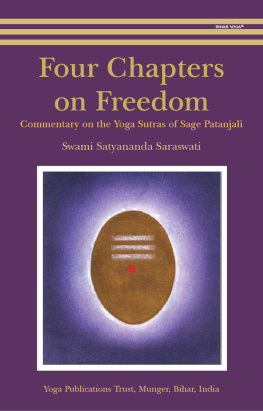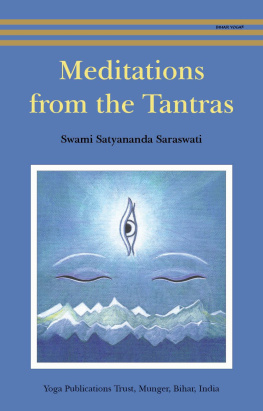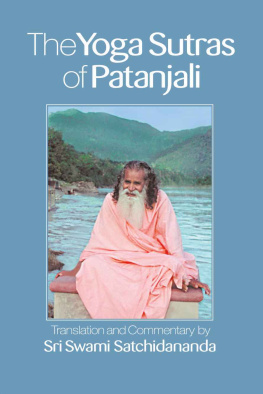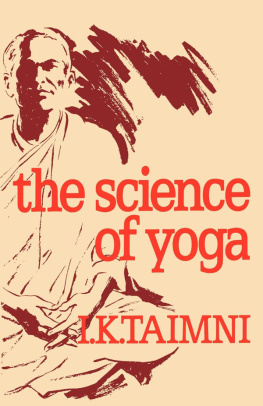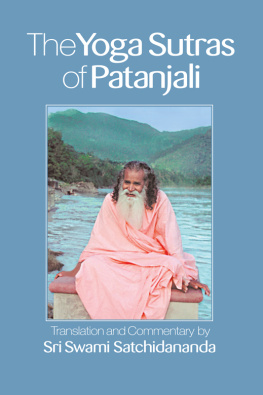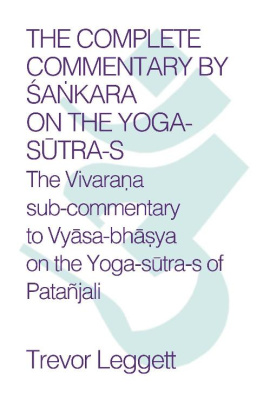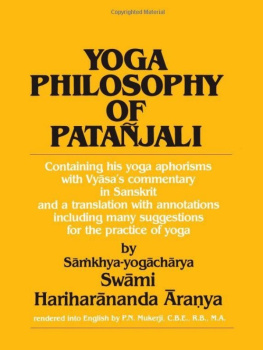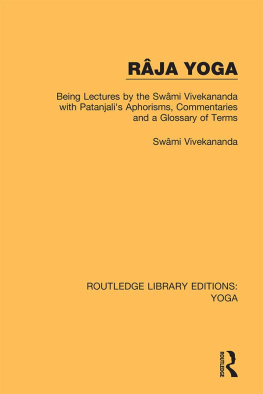Swami Satyananda Saraswati - Four Chapters on Freedom: Commentary on the Yoga Sutras of Sage Patanjali
Here you can read online Swami Satyananda Saraswati - Four Chapters on Freedom: Commentary on the Yoga Sutras of Sage Patanjali full text of the book (entire story) in english for free. Download pdf and epub, get meaning, cover and reviews about this ebook. year: 2016, publisher: Yoga Publications Trust, genre: Religion. Description of the work, (preface) as well as reviews are available. Best literature library LitArk.com created for fans of good reading and offers a wide selection of genres:
Romance novel
Science fiction
Adventure
Detective
Science
History
Home and family
Prose
Art
Politics
Computer
Non-fiction
Religion
Business
Children
Humor
Choose a favorite category and find really read worthwhile books. Enjoy immersion in the world of imagination, feel the emotions of the characters or learn something new for yourself, make an fascinating discovery.
- Book:Four Chapters on Freedom: Commentary on the Yoga Sutras of Sage Patanjali
- Author:
- Publisher:Yoga Publications Trust
- Genre:
- Year:2016
- Rating:5 / 5
- Favourites:Add to favourites
- Your mark:
- 100
- 1
- 2
- 3
- 4
- 5
Four Chapters on Freedom: Commentary on the Yoga Sutras of Sage Patanjali: summary, description and annotation
We offer to read an annotation, description, summary or preface (depends on what the author of the book "Four Chapters on Freedom: Commentary on the Yoga Sutras of Sage Patanjali" wrote himself). If you haven't found the necessary information about the book — write in the comments, we will try to find it.
Swami Satyananda Saraswati: author's other books
Who wrote Four Chapters on Freedom: Commentary on the Yoga Sutras of Sage Patanjali? Find out the surname, the name of the author of the book and a list of all author's works by series.
Four Chapters on Freedom: Commentary on the Yoga Sutras of Sage Patanjali — read online for free the complete book (whole text) full work
Below is the text of the book, divided by pages. System saving the place of the last page read, allows you to conveniently read the book "Four Chapters on Freedom: Commentary on the Yoga Sutras of Sage Patanjali" online for free, without having to search again every time where you left off. Put a bookmark, and you can go to the page where you finished reading at any time.
Font size:
Interval:
Bookmark:
Four Chapters
on Freedom
With kind regards,  and prem
and prem

Four Chapters
on Freedom
Commentary on the Yoga Sutras of Sage Patanjali
Swami Satyananda Saraswati

Yoga Publications Trust, Munger, Bihar, India
YOGA PUBLICATIONS TRUST
Four Chapters on Freedom
The Yoga Sutras of Sage Patanjali is an ancient classical text which succinctly presents the profound teachings of raja yoga in 196 concise sutras or threads. Four Chapters on Freedom is a commentary by Swami Satyananda Saraswati in which he unravels the meaning of the Sutras , verse by verse. Every word of each sutra is significant, and a deep understanding of Sanskrit, as well as the insight of an enlightened master, is needed to interpret them for the modern reader.
Four Chapters on Freedom is a light to guide serious yogic aspirants and spiritual seekers on the eternal path of raja yoga. It includes the Sanskrit text, transliteration and translation of the sutras.
Many sannyasins have selflessly contributed to the compiling, editing and publishing of this text. To one and all, yoga aspirants extend their gratitude for bringing this information to them.
Bihar School of Yoga 1976, 2016
All rights reserved. No part of this publication may be reproduced, transmitted or stored in a retrieval system, in any form or by any means, without permission in writing from Yoga Publications Trust.
The terms Satyananda Yoga and Bihar Yoga are registered trademarks owned by International Yoga Fellowship Movement (IYFM). The use of the same in this book is with permission and should not in any way be taken as affecting the validity of the marks.
Printed by Bihar School of Yoga
First edition 1976
Reprinted 1979, 1989
Printed by Yoga Publications Trust
Reprinted 2000, 2002, 2005, 2006, 2008, 2013
First digital edition 2016
ISBN (print): 978-81-85787-18-2
ISBN eMOBI: 978-93-84753-42-9
ISBN ePUB: 978-93-84753-43-6
Publisher and distributor: Yoga Publications Trust, Ganga Darshan, Munger, Bihar, India.
Website: www.biharyoga.net

Dedication
In humility we offer this dedication to
Swami Sivananda Saraswati, who initiated
Swami Satyananda Saraswati into the secrets of yoga.
Contents
Two pandits entered the ashram to attend satsang. It was a cool, refreshing evening and a large mat had been laid out on the lawn. The pandits were the first to arrive and they sat on the mat directly in front of the gurus seat. Soon many other people arrived and when the guru took his seat, the satsang began.
Initially, the satsang was concerned with asana, pranayama and other yogic practices, but after some time the pandits said to the guru, Weve come here to discuss more important things; we have come to ask you about the philosophical implications of samadhi according to Sage Patanjali. The debate began. One pandit insisted, Asamprajnata samadhi is surely the same as nirbeeja samadhi. The other disagreed, No, no you are totally wrong, they are different. Each began to quote widely from various scriptures to prove their point of view and soon they were having quite a furious argument.
The guru could not get a word in edgeways so he sat in silence. The pandits became oblivious to him, though at one stage one turned to him and asked, What do you think? Is samprajnata different to nirbeeja samadhi, or not? But before the guru could reply, the same pandit continued, The books that Ive read say that they are definitely different. The guru remained silent and the pandits continued their discussion. Eventually they started yelling at each other and almost came to blows.
The heated discussion continued for about half an hour. Then a big, fat, contented cow casually strolled onto the mat as though it owned the place. Everyone was amused at the arrival of the new visitor, everyone that is except the two pandits who were so involved in their debate that they did not see it. People moved out of the way and the cow quietly sat down behind the pandits. The cow seemed to be intently interested in the debate and seriously contemplating the meaning of every word that was spoken.
Suddenly the cow bellowed, M-o-o-o-o-o-o-o , with full approval. The two pandits jumped with fright. For the first time in half an hour they were lost for words. Everyone laughed and the cow slowly arose and lumbered away, perhaps to find another interesting satsang elsewhere.
The cow uttered the wisest words in the satsang. Unknowingly, or perhaps knowingly, it told everyone, including the pandits, that the Yoga Sutras of Sage Patanjali were not written for intellectual debate and speculation. They were written to explain the process and practical methods of raising levels of awareness, gaining deeper wisdom, exploring the potential of the mind and eventually going beyond the mind. The text is primarily practice-orientated; it is not intended to be an intellectual exercise on samadhi. Surely the sage himself would have smiled at the appropriate wise words of the humble cow.
Many of the verses indicate things that are beyond the range of normal mundane experience and comprehension. This is not done to bring intellectual understanding; it is so that a sadhaka , aspirant, who practises the Patanjali yoga or any other system will progressively gain insight and understanding of the deeper aspects of his being. He will gradually understand Sage Patanjalis cryptic verses through his own experience. The verses tell him if he is going in the right direction or not and also help him to proceed further. The verses can never be understood intellectually, nor are they intended to be understood in this manner. The verses were written as a map, a guide for the journey from mundane levels to higher levels of consciousness and eventually to liberation. The text shows the path to perfect freedom through sustained yogic practice.
Everything that needs to be said is contained within the verses of the Yoga Sutras and in the commentary. The purpose of this introduction is to:
Give basic background information.
Highlight the incredible consistency and perfection of the verses so that the reader can more easily and clearly see the yogic, scientific and psychological truths contained within the main text.
Point out the things that you should notice, but which you may otherwise so easily miss in the simplicity of the verses.
Structure of the text
This book is a commentary on the Yoga Sutras , a scripture of 196 sutras (verses) written by Sage Patanjali. In English the text can be called Verses on Yoga, but actually the word sutra means thread. The word implies that the written words carry an underlying continuous thought; the various ideas connect together like the beads on a mala to form a complete philosophy.
The scripture is also called Yoga Darshana , which is widely translated as Philosophy of Yoga, but actually the word darshana has a much deeper meaning. Literally, it means to see. It is derived from drish , meaning to see and is related to the word drashta , meaning the seer. Darshana is the process of seeing. Therefore, Y oga Darshana means a process of seeing through yoga, but it does not mean seeing with the eyes, nor does it mean seeing with any other senses in the outside world. It means to see something beyond the senses and beyond the mind. It is a process of seeing with the eyes and other senses closed, and with the mind under complete control. Yoga Darshana is a method of higher perception; it is a means to see the invisible or to see with spiritual insight.
Next pageFont size:
Interval:
Bookmark:
Similar books «Four Chapters on Freedom: Commentary on the Yoga Sutras of Sage Patanjali»
Look at similar books to Four Chapters on Freedom: Commentary on the Yoga Sutras of Sage Patanjali. We have selected literature similar in name and meaning in the hope of providing readers with more options to find new, interesting, not yet read works.
Discussion, reviews of the book Four Chapters on Freedom: Commentary on the Yoga Sutras of Sage Patanjali and just readers' own opinions. Leave your comments, write what you think about the work, its meaning or the main characters. Specify what exactly you liked and what you didn't like, and why you think so.

